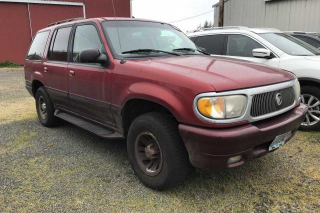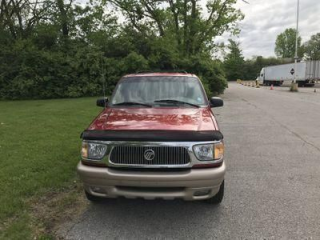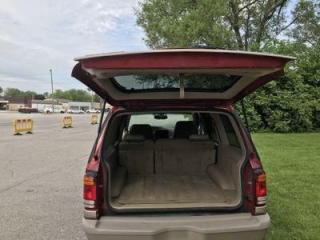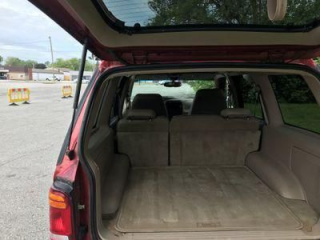The Good
The 1999 Mercury Mountaineer offered a compelling blend of advantages. Its robust V8 engine provided confident performance and strong towing capabilities, appealing to practical buyers needing utility. Comfortable seating and a relatively smooth ride, especially compared to some rivals, catered to emotional desires for a pleasant driving experience. The distinctive, somewhat upscale design gave it a unique identity. While not exceptionally efficient, its sturdy build promised decent reliability, and as a used vehicle, it offered good value for a full-frame SUV.
The Bad
Known weaknesses for the 1999 Mercury Mountaineer include potential issues with the automatic transmission, particularly after high mileage. Rust on the chassis and body panels can be a concern, especially in salt-belt regions. Interior trim pieces may degrade or rattle over time, and suspension components, like ball joints and bushings, often require replacement. Fuel economy is also a significant drawback for many prospective owners.
1999 Mercury Mountaineer: Quick Overview
- Engine Options: The 1999 Mercury Mountaineer primarily offered one main engine option, a robust V8.
- 5.0L "Windsor" V8 engine.
- Horsepower:
- 5.0L V8: Approximately 215 hp at 4200 rpm.
- Fuel Economy (Estimated EPA):
- 5.0L V8 (2WD/4WD): Around 13-14 MPG city / 18-19 MPG highway.
- Note: Real-world figures can vary based on driving conditions and maintenance.
- 0-60 Times (Estimated):
- With the 5.0L V8, 0-60 mph times were typically in the 8.5-9.5 second range, which was competitive for an SUV of its size and era.
- Towing Capacity:
- With the 5.0L V8 and proper equipment, the Mountaineer could tow approximately 5,000 to 6,700 lbs, depending on the configuration (2WD/4WD) and specific options. This made it a capable hauler for boats, trailers, or RVs.
- Trim-Level Features: The 1999 Mountaineer was generally offered in a single, well-equipped trim level with various optional packages.
- Standard Features: Included power windows, power door locks, power mirrors, air conditioning, cruise control, a tilt steering wheel, and a premium AM/FM stereo with a CD player.
- Interior Appointments: Often came standard with cloth upholstery, but leather seating surfaces were a very popular option, often bundled with power-adjustable front seats.
- Exterior Features: Standard alloy wheels, roof rack, fog lights, and a unique grille design that differentiated it from the Ford Explorer.
- Convenience Options: Keyless entry, automatic climate control, a power moonroof, and an upgraded audio system with a cassette player were commonly available.
- Drivetrain: Available in both two-wheel drive (2WD) and ControlTrac four-wheel drive (4WD) systems. The 4WD system offered auto, 4-high, and 4-low settings.
1999 Mercury Mountaineer Specifications
Vehicle Information
| Year | 1999 |
| Make | Mercury |
| Model | Mountaineer |
| Trim | - |
| Style | 2WD 5-Speed Automatic |
| Type | Sport Utility Vehicle |
| Category | Standard Sport Utility Vehicle |
Manufacturing Details
| Made In | United States |
| Manufacturing City | WIXOM |
Dimensions
| Doors | 4-Door |
| Curb Weight | 3942 pounds |
| Gross Vehicle Weight Rating | 6000 pounds |
| Overall Height | 70.50 inches |
| Overall Length | 190.10 inches |
| Overall Width | 70.20 inches |
| Wheelbase Length | 111.60 inches |
| Standard Seating | 5 |
Engine & Performance
| Engine | 5.0-L V-8 OHV 16V |
| Engine Size | 5L |
| Engine Cylinders | 8 |
| Transmission | 5-Speed Automatic |
| Transmission Type | Automatic |
| Transmission Speeds | 5-Speed |
| Drivetrain | Rear-Wheel Drive |
Additional Features
| Anti-Brake System | 4-Wheel ABS |
| Steering Type | Rack & Pinion |
Pricing
| Manufacturer Suggested Retail Price (MSRP) | $27,255 |
| Invoice Price | $24,620 |
| Delivery Charges | - |
Vehicle History Report
Specifications
History
Events
History Check
Check
Check
Check
Check
Listings
Recalls
Check
Analysis
What Problems Does the 1999 Mercury Mountaineer Have?
Another widespread concern for these vehicles, especially in regions exposed to road salt, is frame and body rust. The rear leaf spring mounts, shock mounts, and underbody cross members are particularly susceptible. Extensive rust can compromise structural integrity and make maintenance difficult.
Suspension components are also frequent points of failure. Ball joints, tie rod ends, control arm bushings, and sway bar links tend to wear out, leading to clunking noises, poor handling, and uneven tire wear. Owners should also inspect the steering gearbox for leaks or excessive play.
The 5.0L V8 engine itself is generally reliable, but accessories and sensors can fail. Common engine-related complaints include issues with the idle air control (IAC) valve, mass airflow (MAF) sensor, and oxygen sensors, which can cause rough idling, stalling, or poor fuel economy. The plastic intake manifold (particularly on later 5.0L models, though less common on the '99 Mountaineer compared to other Ford V8s) can also crack, leading to coolant leaks.
Electrical gremlins are not uncommon, ranging from power window failures and malfunctioning door locks to instrument cluster issues and intermittent lighting problems. The blend door actuator for the HVAC system is also known to fail, resulting in improper temperature control.
Regarding recalls for the 1999 model year, there were several. One notable recall involved the speed control deactivation switch, which could potentially overheat and cause a fire. This issue affected a wide range of Ford/Mercury vehicles from this era. Another recall pertained to the parking brake cable, which could fray or break, reducing braking effectiveness. It is crucial for potential buyers to check if these, and any other relevant recalls, have been addressed by reviewing the vehicle's VIN with a dealership or online database.
How long will the 1999 Mercury Mountaineer last?
What Technology & Safety Features are Included?
Built-in Tech & Entertainment:
- Audio System: Standard was an AM/FM stereo with a CD player. Optional upgrades included a premium sound system, often with an integrated cassette player, and sometimes a multi-CD changer in the console or trunk.
- Climate Control: Manual air conditioning was standard, with an optional automatic climate control system providing more precise temperature regulation. Rear seat auxiliary climate controls were also a common option.
- Convenience Features: Power windows, power door locks, power mirrors, and cruise control were standard. Keyless entry with a remote fob was a highly sought-after option, as were a power moonroof and a universal garage door opener.
- Airbags: Dual front airbags (for driver and front passenger) were standard. Side airbags were not typically offered for this model year.
- Brakes: Four-wheel anti-lock brakes (ABS) were standard, providing improved stopping performance and control, especially on slippery surfaces.
- Traction & Stability Control: Advanced electronic stability control systems were not available for the 1999 model year. However, the available ControlTrac 4WD system offered enhanced traction in various conditions.
- Seatbelts: Three-point seatbelts were provided for all outboard seating positions, with a lap belt for the center rear passenger.
- Child Safety: Rear child safety seat anchors (LATCH system) were beginning to be introduced around this time, but the Mountaineer would primarily rely on seatbelt-based attachment. Rear door child safety locks were standard.
- Headlights: Automatic on/off headlights were sometimes an optional convenience feature.
For the 1999 Mercury Mountaineer (and its Ford Explorer twin), crash test ratings from organizations like the National Highway Traffic Safety Administration (NHTSA) were generally available.
- NHTSA Frontal Crash Test: Typically received 4 out of 5 stars for both driver and passenger in frontal impact tests.
- NHTSA Side Impact Test: Ratings usually ranged from 3 to 4 out of 5 stars for front and rear occupants.
- Rollover Rating: Due to its SUV body style and higher center of gravity, rollover ratings were often 3 out of 5 stars.
What Colors Options are Available?
1999 Mercury Mountaineer Prices and Market Value
1999 Mercury Mountaineer Cost of Ownership
1999 Mercury Mountaineer Fuel Efficiency
1999 Mercury Mountaineer Safety Rating
NHTSA
IIHS
1999 Mercury Mountaineer Warranty
Basic
Powertrain
Rust
1999 Mercury Mountaineer Insurance
reasonable repair costs.
How Does the 1999 Mercury Mountaineer Compare to Other Sport Utility Vehicle?
Performance: The Mountaineer's standard 5.0L V8 gave it a distinct advantage in performance over most base engine rivals like the Blazer's 4.3L V6 or even the Grand Cherokee's inline-six. Its acceleration and towing capacity were strong points. However, the Grand Cherokee offered a more potent 5.9L V8 option, and the 4Runner/Pathfinder typically had smoother, albeit less powerful, V6 engines.
Features: The Mountaineer generally offered a slightly more upscale interior and more standard comfort features than a comparably equipped Ford Explorer. It was competitive with the Grand Cherokee in terms of luxury options (leather, automatic climate control) but often surpassed the Blazer/Jimmy. The Japanese rivals, while well-appointed, sometimes lagged in V8 power options.
Reliability: This is where the Mountaineer, like its Explorer sibling, faced significant challenges. Its automatic transmission issues and propensity for rust (especially the frame) often put it at a disadvantage compared to the more robust and famously reliable Toyota 4Runner and Nissan Pathfinder. The Jeep Grand Cherokee also had its share of electrical gremlins and cooling system issues, while the Blazer/Jimmy suffered from various engine and transmission problems as well. The Mountaineer's 5.0L V8 engine itself was generally strong, but supporting components could falter.
Price: New, the Mountaineer was priced competitively, often a bit higher than a comparable Explorer but generally in line with the Grand Cherokee and less than top-trim 4Runners. On the used market today, due to its depreciation and reliability concerns, it is often among the more affordable V8-powered SUVs from its class and era, sometimes cheaper than a comparable Grand Cherokee and significantly less than a 4Runner.
Alternatives:
- For better reliability: The Toyota 4Runner (3rd Gen) is a superior alternative, known for legendary reliability, strong resale value, and robust off-road capability, though it will typically cost more on the used market.
- For similar V8 power and capability with potential luxury: The Jeep Grand Cherokee (ZJ/WJ generations) offers comparable V8 power (especially the 5.9L Limited) and luxury features, often at a similar price point on the used market, but also comes with its own set of potential reliability issues.
- For a more basic, rugged experience: The Ford Explorer (its sibling) offers almost identical mechanics but often at a lower price point, especially if luxury isn't a priority.
Final Verdict: Is the 1999 Mercury Mountaineer a Good Sport Utility Vehicle?
Is it worth buying today? Yes, but under strict conditions. It's worth buying if you find a well-documented example with a solid maintenance history, especially one where the transmission has either been recently serviced or replaced, and rust is minimal. It's an excellent choice for a DIY mechanic willing to tackle common issues, or for someone needing an affordable secondary vehicle. Avoid neglected examples or those with significant rust or transmission problems unless you&re getting it for parts. Consider it a budget-friendly workhorse, not a worry-free daily driver, unless it has received substantial care.




